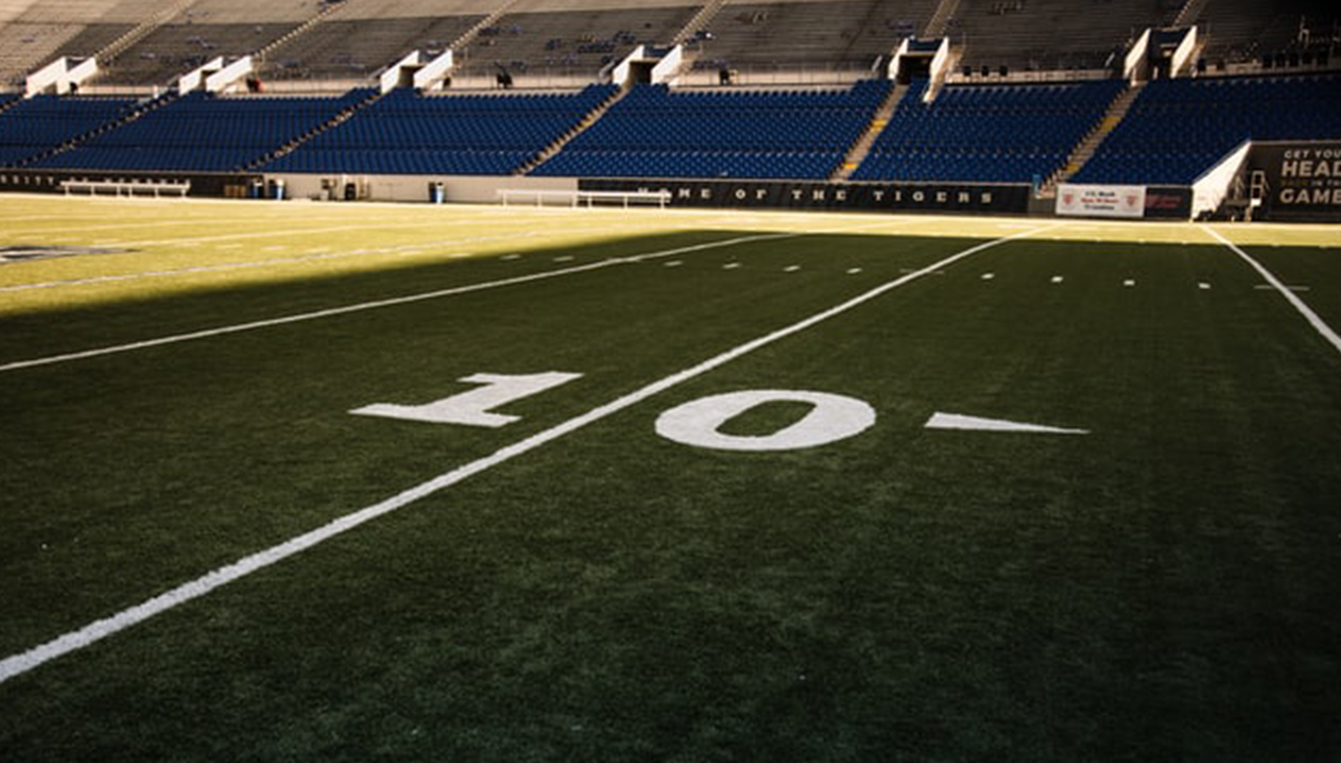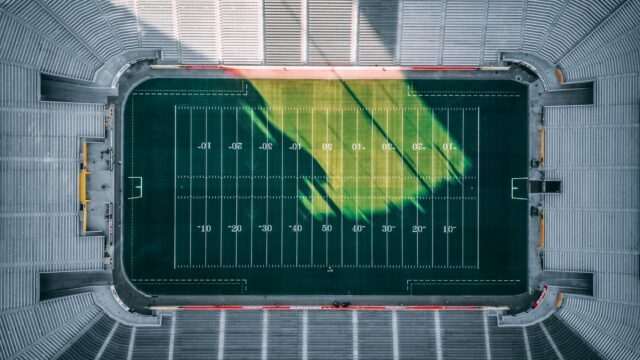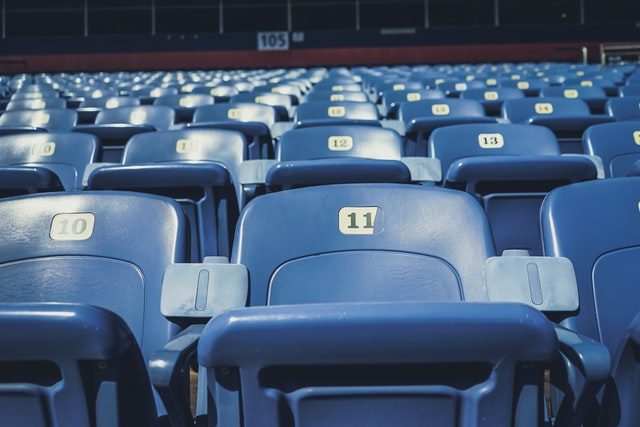Alexander Roehl
Senior Consultant

If you’ve been watching football this year, you know that broadcasters have been adding fake crowd noise to games to compensate for the lack of fans in the stadiums. With the season behind us and the Super Bowl bringing in more casual fans this Sunday, we thought this would be the perfect time to dig into some of the hows and whys of artificial crowd noise as it’s been used by the NFL this year.
A Little Background (Noise)
Unlike most other professional sports that had their seasons interrupted by the COVID lockdowns, the NFL was relatively lucky to be in the offseason when things got bad. This gave league officials some time to watch and learn from other sports leagues, then shape their strategy as well as develop the technology to do it well.
Despite a number of people (John Madden not the least among them) calling for the league to lean into the unique situation and provide “enhanced audio” for games without fans by adding more on-field microphones, league officials decided fairly quickly that they wanted to add crowd noise. Frank Gaudelli, executive producer of Sunday Night Football, spent his summer watching other sports leagues without added fan noise and was quoted saying “It gets dull really quickly. I mean, there’s just no energy.” If you watched those other sports leagues over the summer along with Mr. Gaudelli, though, you’ll have realized that some implementations of artificial crowd noise are more successful than others.
I Don’t Believe My Ears
The biggest challenge in getting artificial crowd noise right is the fact that our senses are linked together. When what you hear doesn’t match what you see, your brain tries to stitch things together in a way that makes sense, leaving you feeling uneasy if you can’t reconcile the two. Some early-pandemic baseball broadcasts especially seemed to be criticized for the disconnect between adding dynamic crowd audio while using relatively static digital fans in the stadiums (or very static cardboard cutouts).
Even if the video is shot tight to the field so that the empty seats aren’t visible, the crowd noise also needs to make sense. The noise needs to rise and fall at the right moments to make the simulated crowd react to the plays as they happen, but it isn’t quite as simple as just turning up and down the volume. For example, think of how the timbre of the crowd changes from offense to defense, one cheering on the team, the other trying to drown out and intimidate. And that’s to say nothing of team-specific cheers – the “Skol!” chant might add that extra bit of immersion for a Vikings home game, but it would bring you completely out of the action on Sunday.

Getting it Right
As it turns out, NFL Films has spent the past 4 years capturing stadium audio for every team in the league. The NFL was able to draw from this massive library to create custom audio palettes for each team in the league, including not only baseline crowd sound levels at various different energy levels but also positive and negative quick-fire reactions. Specialized sound systems were built for each team with 4 levels of general crowd ambiance and 3 levels of both positive and negative reactions. During the game, an operator adjusts the level of overall crowd noise depending on how loud they think the crowd should be and fires off reactions as the play develops. To keep the audio from getting stale, the systems randomly pull the reaction sounds from large libraries of each category.
The operators trained to use these systems were not only experienced audio engineers but also fans of those teams. Not only did this mean they were more likely to be emotionally invested in the game, but they also had a good sense of how their fan base should sound in their stadium instead of trying to create an “ideal” or generic crowd from scratch.
Of course, that doesn’t mean everything worked perfectly right from the start. Especially in the early weeks of the season, there were complaints that the levels were off or reactions were coming in too late. As the operators became more adept with their controllers and the league adjusted their protocols (such as not reacting to replays or being more sparing with the boos) the overall quality of the mix improved. There will always be people who aren’t happy, but by this point, most fans seem to have accepted or at least gotten used to the artificial crowd.
Inside the Stadium
It’s worth pointing out that this dynamic crowd audio wasn’t allowed to be played inside the stadiums this year, so no one could deafen their rivals with the sound of 70,000 people booing like crazy on every play. Instead, the NFL created a second, static crowd noise loop to be played in the stadium from before kickoff to the end of the game. This audio was originally supposed to be played at 70 decibels for every game, but the rules were later changed that the sound levels could be increased to 80 decibels in stadiums with less than 2,500 people in attendance and could be omitted completely in stadiums with more people.
This noise was intended to mask what the NFL refers to as “some field-level audio typically not audible in a stadium with fans.” Whether this is referring to conversations among coaching staff of the two teams or colorful language not fit for broadcast TV, the concept here is the same as a sound masking system that we might recommend for an open office environment: adding in a constant level background sound at a level that sounds natural to make it more difficult to hear and understand potentially distracting sounds.
One of the biggest challenges in successfully implementing a sound masking system, whether in an NFL stadium or an office, is making the added noise sound like it belongs in the space. In an office environment, a well-designed sound masking system is tuned to sound like an HVAC system and the loudspeaker layouts are carefully coordinated to provide even coverage so that there are no “hot spots” that draw your attention to the loudspeakers in the ceiling. The overall level of the system is also adjusted so that it’s loud enough to effectively mask the unwanted sounds without itself becoming a distraction.
Obviously, the acoustic environment of an NFL stadium is very different from an office, but the same basics apply. Crowd noise makes sense in a stadium, and by running for the entire game without changing level it doesn’t draw attention to itself. The 70-80 decibel range is a far cry from the world record for the loudest crowd roar in a stadium, set at 142 dBA by the Kansas City Chiefs in 2014 (a claim we’ve previously investigated), but is likely loud enough to make most on-field conversation unintelligible without special microphones pointed at the speaker.

The Big Game
Of course, the Super Bowl isn’t just any game, even with the Buccaneers playing at their regular home stadium. About 25,000 people will be in attendance, more than were permitted during regular-season games at Raymond James stadium. With the stadium at about a third of its maximum capacity, we expect there to be enough noise from the crowd that the in-stadium masking noise won’t be necessary, but not enough to give the broadcast the energy and sense of spectacle that we expect from the Super Bowl. The most likely solution is probably to augment the noise from the stadium with the artificial crowd, but what audio libraries will they use? Will they just use the same sounds they’ve been using all season for Buccaneers games at the Raymond James, or will they pull in Chiefs-specific chants to balance out the playing field? Will they be using the full complement of sounds in their libraries, or might they just add the baseline crowd noise and leave the play reactions to the live audience? Only one thing’s for sure – we’ll be listening.